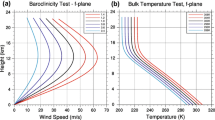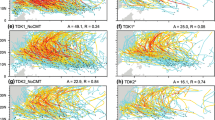Abstract
In this study, the characteristics of moist potential vorticity (MPV) in the vicinity of a surface cyclone center and their physical processes are investigated. A prognostic equation of surface absolute vorticity is then used to examine the relationship between the cyclone tracks and negative MPV (NMPV) using numerical simulations of the life cycle of an extratropical cyclone. It is shown that the MPV approach developed herein, i.e., by tracing the peak NMPV, can be used to help trace surface cyclones during their development and mature stages. Sensitivity experiments are conducted to investigate the impact of different initial moisture fields on the effectiveness of the MPV approach. It is found that the lifetime of NMPV depends mainly on the initial moisture field, the magnitude of condensational heating, and the advection of NMPV. When NMPV moves into a saturated environment at or near a cyclone center, it can trace better the evolution of the surface cyclone due to the conservative property of MPV. It is also shown that the NMPV generation is closely associated with the coupling of large potential temperature and moisture gradients as a result of frontogenesis processes. Analyses indicate that condensation, confluence and tilting play important but different roles in determining the NMPV generation. NMPV is generated mainly through the changes in the strength of baroclinicity and in the direction of the moisture gradient due to moist and/or dry air mass intrusion into the baroclinic zone.
Similar content being viewed by others
References
Anthes, R. A., E.-Y. Hsie, and Y.-H. Kuo, 1987: Description of the Penn State/NCAR Mesoscale Model Version 4 (MM4). NCAR Tech. Note, NCAR / TN-282, 66pp.
Betts, A. K., and F. J. Dugan, 1973: Empirical formula for saturation pseudoadiabats and saturation equivalent potential temperature.J. Appl. Meteor.,12, 731–732.
Browning, K. A., 1990: Organization of clouds and precipitation in extratropical cyclones.Extratropical Cyclones. The Erik Palmen Memorial Volume, C. W. Newton and E. Holopainen, Eds., Amer. Meteor. Soc., 132.
Cao, Z., and H.-R. Cho, 1995: Generation of moist potential vorticity in extratropical cyclones.J. Atmos. Sci.,52, 3263–3281.
Cao, Z., and G. W. K. Moore, 1998: A diagnostic study of moist potential vorticity generation in an extratropical cyclone.Adv. Atmos. Sci.,15, 152–166.
Cao, Z., R. E. Stewart, and W. D. Hogg, 2001: Extreme winter warming events over the Mackenzie basin: Dynamic and thermodynamic contributions.J. Meteor. Soc. Japan,79, 785–804.
Cao, Z., M. Wang, B. A. Proctor, G. S. Strong, R. E. Stewart, H. Ritchie, and J. E. Burford, 2002: On the physical processes associated with the water budget and discharge of the Mackenzie Basin during the 1994/1995 water year.Atmos.-Ocean,40, 125–143.
Cao, Z., and D. -L. Zhang, 2004: Tracking surface cyclones with moist potential vorticity.Adv. Atmos. Sci.,21, 830–835.
Cao, Z., P. Pellerin, and H. Ritchie, 2004: Verification of mesoscale modeling for the severe rainfall event over southern Ontario in May 2000.Geophys. Res. Lett.,31, L23108, doi:10.1029/2004GL020547.
Colle, B. A., and C. F. Mass, 1999: An observational and numerical study of a cold front interacting with the Olympic Mountains during COAST IOP5.Mon. Wea. Rev.,127, 1310–1334.
Davis, C. A., and K. A. Emanuel, 1991: Potential vorticity diagnosis of cyclogenesis.Mon. Wea. Rev.,119, 1929–1953.
Fraedrich, K., R. Bach, and G. Naujokat, 1986: Single station climatology of central European fronts: Number, time and precipitation statistics.Contrib. Atmos. Phys.,59, 54–65.
Gao, S., X. Li, and W.-K. Tao, 2004: A convective vorticity vector associated with tropical convection: A two-dimensional cloud-resolving modeling study.J. Geophys. Res.,109, D14106, doi:10.1029/2004JD004807.
Gyakum, J., 1983: On the evolution of the QE II storm. II: Dynamic and thermodynamic structure.Mon. Wea. Rev.,111, 1156–1173.
Gyakum, J., D.-L. Zhang, J. Witte, K. Thomas, and W. Wintels, 1996: CASP II and Canadian cyclones during the 1989–92 cold seasons.Atmos.-Ocean,34, 1–16.
Hoskins, B. J., M. E. McIntyre, and A. W. Robertson, 1985: On the use and significance of isentropic potential vorticity maps.Quart. J. Roy. Meteor. Soc.,111, 877–946.
Hsie, E.-Y., R. A. Anthes, and D. Keyser, 1984: Numerical simulation of frontogenesis in a moist atmosphere.J. Atmos. Sci.,41, 2581–2594.
Hu, Q., and E. R. Reiter, 1987: A diagnostic study of explosive cyclogenesis in the lee of the Rocky Mountains.Meteor. Atmos. Phys.,36, 161–184.
Huo, Z., D.-L. Zhang, and J. Gyakum, 1998: An application of potential vorticity inversion to improving the numerical prediction of the March 1993 superstorm.Mon. Wea. Rev.,126, 424–436.
Neiman, P. J., and M. A. Shapiro, 1993: The life cycle of an extratropical marine cyclone. Part I: Frontalcyclone evolution and thermodynamic air-sea interaction.Mon. Wea. Rev.,121, 2153–2176.
Neiman, P. J., M. A. Shapiro, and L. S. Fedor, 1993: The life cycle of an extratropical marine cyclone. Part II: Mesoscale structure and diagnostics.Mon. Wea. Rev.,121, 2177–2199.
Petterssen, S., 1936: Contribution to the theory of frontogenesis.Geofys. Publ.,11, 1–27.
Reed, R. J., G. A. Grell, and Y.-H. Kuo, 1993: The ERICA IOP 5 storm. Part II: Sensitivity tests and further diagnosis based on model output.Mon. Wea. Rev.,121, 1595–1612.
Roebber, P. J., 1984: Statistical analysis and updated climatology of explosive cyclones.Mon. Wea. Rev.,112, 1577–1589.
Shapiro, M. A., and D. Keyser, 1990: Fronts, jet streams, and the tropopause.Extratropical cyclones. The Erik Palmn Memorial Volume, C. W. Newton and E. Holopainen, Eds., Amer. Meteor. Soc., 161–191.
Szeto, K. K., A. Tremblay, H. Guan, D. R. Hudak, R. E. Stewart, and Z. Cao, 1999: The mesoscale dynamics of freezing rain storms over eastern Canada.J. Atmos. Sci.,56, 1261–1281.
Thorpe, A. J., and S. A. Clough, 1991: Mesoscale dynamics of cold fronts: Structures described by dropsoundings in FRONTS 87.Quart. J. Roy. Meteor. Soc.,117, 903–941.
Uccellini, L. W., 1990: Processes contributing to the rapid development of extratropical cyclones.Extratropical cyclones. The Erik Palmn Memorial Volume, C. W. Newton and E. Holopainen, Eds., Amer. Meteor. Soc., 81–105.
Weldon, R. B., 1979: Satellite training course notes. Part IV. Cloud patterns and upper air wind field. United States Air Force, AWS/TR-79/003.
Zhang, G. J., 2003: Lagrangian study of cloud properties and their relationships to meteorological parameters over the U. S. Southern Great Plains.J. Climate,16, 2700–2716.
Author information
Authors and Affiliations
Rights and permissions
About this article
Cite this article
Cao, Z., Zhang, DL. Sensitivity of cyclone tracks to the initial moisture distribution: A moist potential vorticity perspective. Adv. Atmos. Sci. 22, 807–820 (2005). https://doi.org/10.1007/BF02918681
Received:
Revised:
Issue Date:
DOI: https://doi.org/10.1007/BF02918681




